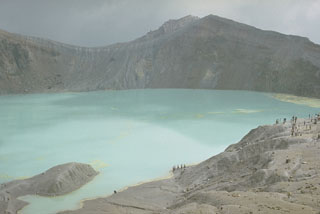Report on Kusatsu-Shiranesan (Japan) — April 1983
Scientific Event Alert Network Bulletin, vol. 8, no. 4 (April 1983)
Managing Editor: Lindsay McClelland.
Kusatsu-Shiranesan (Japan) Small phreatic explosion; harmonic tremor
Please cite this report as:
Global Volcanism Program, 1983. Report on Kusatsu-Shiranesan (Japan) (McClelland, L., ed.). Scientific Event Alert Network Bulletin, 8:4. Smithsonian Institution. https://doi.org/10.5479/si.GVP.SEAN198304-283120
Kusatsu-Shiranesan
Japan
36.618°N, 138.528°E; summit elev. 2165 m
All times are local (unless otherwise noted)
. . . Local seismicity had declined after the December activity, but increased in early January (see table 1), when 91 volcanic earthquakes and 44 tremor events were recorded. After mid-January no tremor events were recorded, but the number of volcanic earthquakes was greater than background level in early March.
At 0459 on 9 March the seismograph at Maebashi District Meteorological Observatory recorded a swarm of volcanic earthquakes that lasted only a few minutes. JMA scientists noted that these earthquakes were similar in wave form to those recorded during previous eruptions. . . . In April, activity was limited to occasional white vapor ejections. On 10 April, one vapor plume rose to 60 m above Yugama Crater. Volcanic tremor, possibly accompanied by vapor ejections, was observed 9-12 and 19-20 April.
Geological Summary. The Kusatsu-Shiranesan complex, located immediately north of Asama volcano, consists of a series of overlapping pyroclastic cones and three crater lakes. The andesitic-to-dacitic volcano was formed in three eruptive stages beginning in the early to mid-Pleistocene. The Pleistocene Oshi pyroclastic flow produced extensive welded tuffs and non-welded pumice that covers much of the E, S, and SW flanks. The latest eruptive stage began about 14,000 years ago. Historical eruptions have consisted of phreatic explosions from the acidic crater lakes or their margins. Fumaroles and hot springs that dot the flanks have strongly acidified many rivers draining from the volcano. The crater was the site of active sulfur mining for many years during the 19th and 20th centuries.
Information Contacts: JMA, Tokyo.

